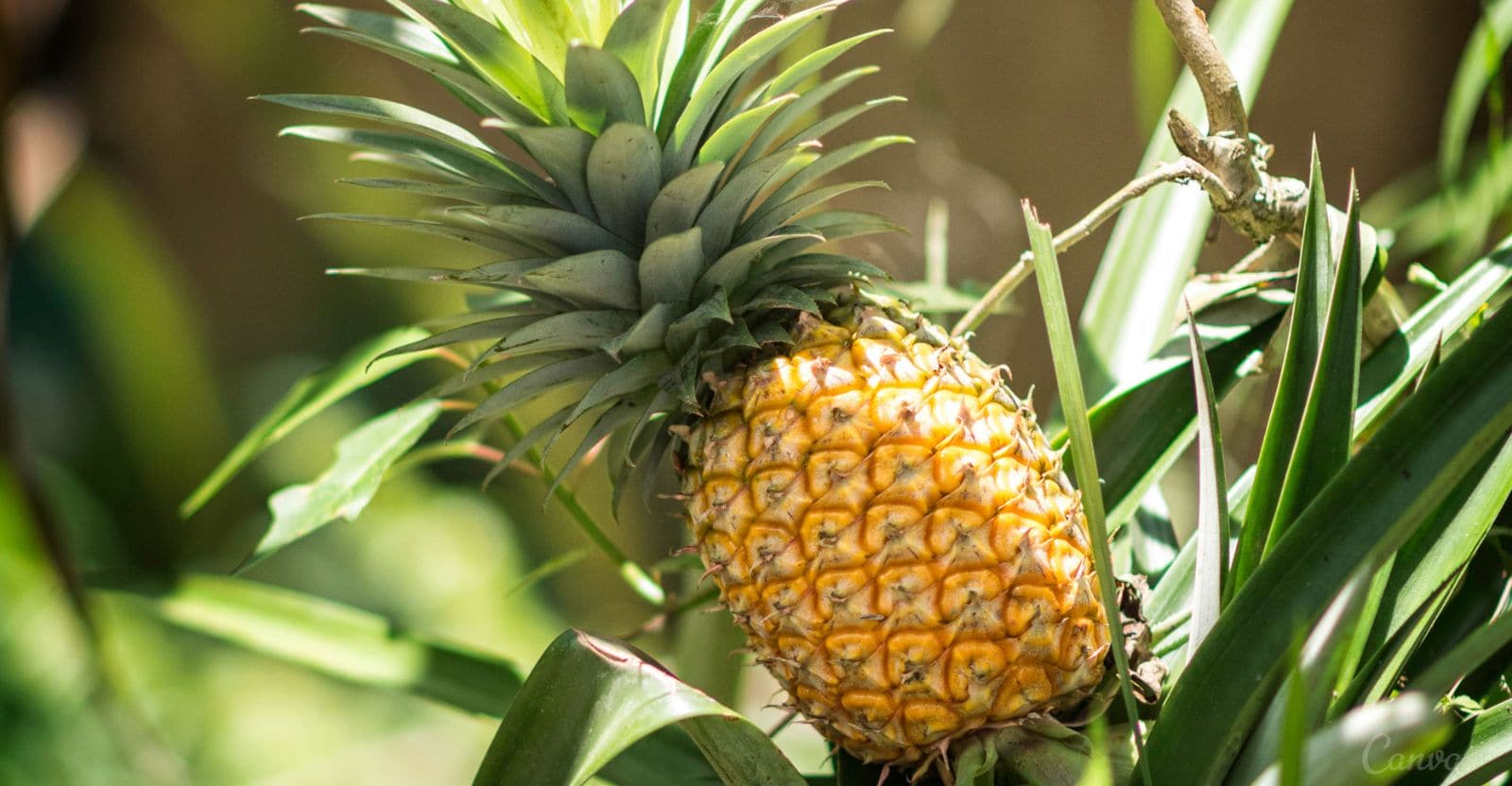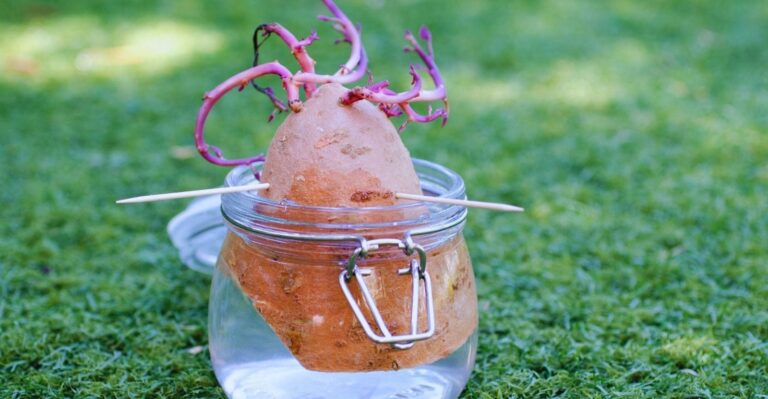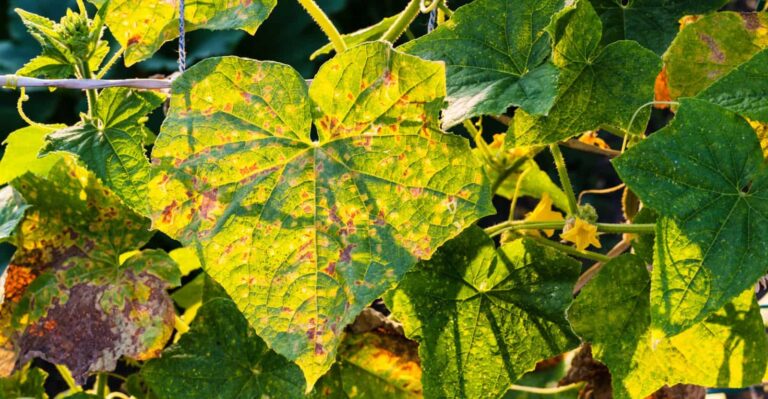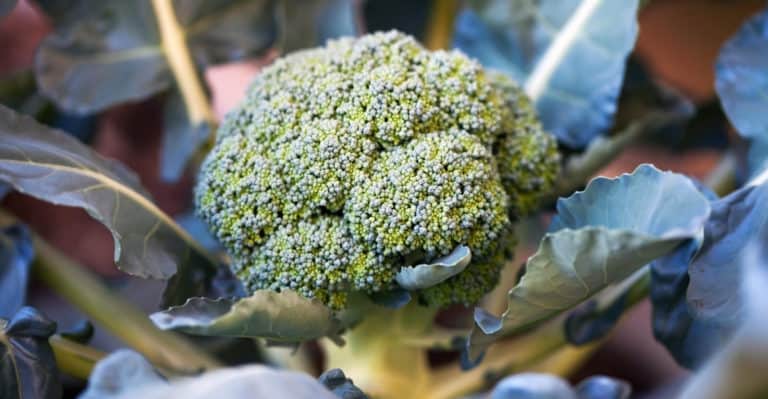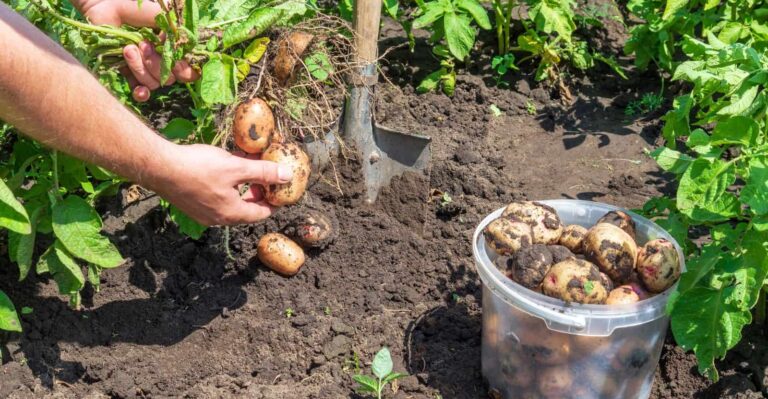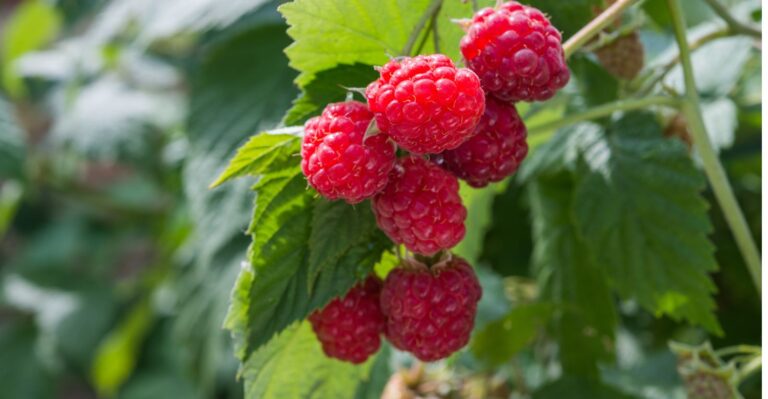Amazon has put together some great Home Gift Deals – save money and get your shopping done at the comfort of your home! Click here to see deals on Amazon
If you’re thinking of growing pineapple plants, you don’t have to be a professional gardener to do it.
Growing pineapple only takes a relatively small amount of time and care.
It’s easy enough for beginners to grow a plant that provides sweet organic fruit or grow as an ornamental pineapple plant.
Pineapples were first cultivated in Brazil several thousands of years ago, but today they’re grown in several tropical and subtropical regions.
You may think that growing pineapple plant is only possible for those who live in a tropical part of the world, but it’s a great plant to grow indoor, outdoor, or container garden at any tropical or non-tropical part of the world.
Some people consider growing pineapple as “hobby farming” as opposed to commercial farming.
But if you’re determined, you can take it beyond that and have your juicy pineapple grown right in your backyard.
If you want to plant an edible garden, let’s get started growing pineapple plants.
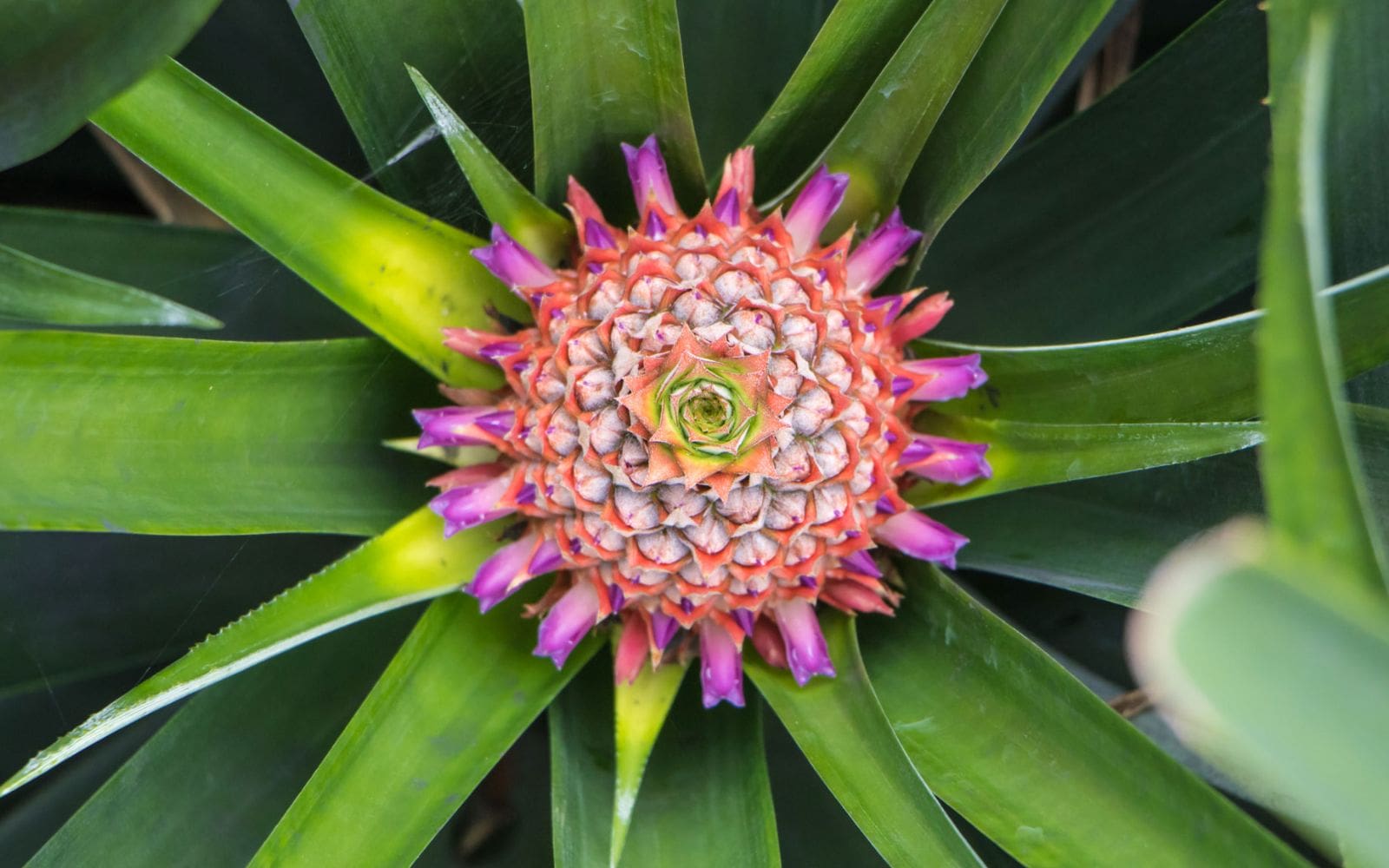
What is a pineapple plant?
Pineapple is a tropical plant with spiky foliage that is widely popular in North America. It has a sweet and juicy pulp full of nutrients and a delicious snack.
Pineapple, scientifically known as Ananas comosus, is a member of the bromeliad family. It’s a large berry containing edible pulp inside with razor-sharp spikes on the outside.
The pineapple fruit isn’t a pinecone, as it doesn’t have scales, and neither is a berry as it has a thick fibrous outside shell. There are several different varieties available in the market.
Most commercial pineapple grower plant Smooth Cayenne variety, which has a bigger fruit and is more pest-resistant with longer shelf life.
These commercial plantations happen in Florida, Hawaii, and South America, such as Brazil and Paraguay. At these places, the well-drained and dry tropical climate helps plants to grow to their fullest.
What are the varieties of pineapple plants?
The pineapple plant is part of the bromeliad family whose fruits grow on trees than in soil.
But pineapple does not grow on a tree but grows on a bush closer to the ground.
Here are some popular varieties of pineapple.
| Variety | Description |
|---|---|
| Smooth Cayenne | Widely grown with 3 feet long leaves and fruit weighs 5 lbs to 6 lbs |
| Red Spanish | Spiky leaves with fruit weigh 2 lbs to 4 lbs and pale-yellow flesh |
| Del Monte Gold (MD-2) | 3 feet long leaves with fruit weighs 3 lbs to 4 lbs and has a yellow pulp |
| Queen Pineapple | Sharp spiked leaves with fruit weigh 2 lbs to 3 lbs and have a crisp texture |
| Singapore Spanish | 3 feet long less spiked leaves and fruit weigh 3 lbs to 5 lbs |
| Sugarloaf (White or Kona Sugar Loaf) | Smooth leaves and fruit weigh 5 lbs to 6 lbs |
For commercial purposes, pineapple is one of the most popular tropical fruits grown after banana, mango, and orange.
In North America, pineapple is shipped as a fruit to the shopping stores. In contrast, in Asia, it’s usually available as processed pineapple juice or canned fruit.
Plant growing summary:
| Factor | Growth Condition |
|---|---|
| Botanical name | Ananas comosus |
| Water | Light watering |
| Sunlight | Bright indirect light |
| Temperature | Between 60 °F (15.5 °C) and 90 °F (32°C) |
| Fertilizer | Once every 6 to 8 weeks |
| Soil | Moist organic-rich soil |
| USDA Zone | 4–11 indoor and 9–11 outdoors |
How many pineapples will one plant produce?
The pineapple plant produces a single fruit per plant. However, it’s a perennial and after it fruits, it develops offshoots or baby plants that take over the existing plant.
When these tiny plants get the right growing conditions, they fully mature and blossom a new pineapple flower that turns into a fruit.
The growing cycle continues, and a single mother plant can spawn several new plants that grow pineapple on it.
How to propagate pineapple plants?
There are several different ways to propagate a pineapple.
You can grow new cropping from the parent plant’s existing offsets, also known as “suckers,” “slips,” or “pups,” or use a pineapple crown to get started.
Also, you can grow it from pineapple seeds, but it’s time-consuming and a bit difficult.
Propagation through pineapple crown
Growing pineapples from tops are one of the easiest ways to develop a new plant. If you’re lucky, you can successfully try this method on a store-bought fresh pineapple.
But remember that it will need some space to grow as these can reach up to 5 feet high with 4 feet spread.
Follow these steps to propagate it through crown:
Step 1: Choose a healthy but slightly unripe pineapple with fresh leaves for propagation.
Separate the pineapple crown from the fruit by gently twisting it at the top. Remove some bottom leaves so the stalk becomes visible.
Step 2: Dip the crown in a root growth hormone. It’s not needed, but it helps with healthy root development and fast growth.
Step 3: You have an option to propagate it in water or soil directly.
For water propagation, fill clean water in a jar and dip the bottom 2 to 3 inches of pineapple crown in water.
If you’re using home tap water, you should let the water settle to eliminate chlorine and other chemicals.
Alternatively, you can harvest rainwater with a rainwater barrel.
Step 4: If you will propagate it in soil, prepare well-drained potting mix soil, and bury the crown in a soil mix. You can move the container into a location where it can get full sunlight.
Step 5: It may take 1 to 2 months for the roots to shoot up from the crown and be ready to transplant.
If you’re doing multiple plantations, maintain around 5 to 6 feet distance between each plant. This provides plants with enough space to spread.
Step 6: Pineapple is a slow-growing plant, and it takes up to 24 months for it to fruit.
If you’re growing it from suckers and slips, it may take anywhere from 12 to 18 months to fruit. Once the pineapple flowers, it may take up to 6 months to mature and turn into fruit.
Step 7: The pineapple becomes ready to harvest when the fruit turns yellow.
If you find that fruit is still green but getting sunburned, you can cut it and let it ripe on its own for a few days.
Note:
As said earlier, each pineapple produces a single fruit. If you plan to continue with pineapple, you can watch for the short shoots of plants growing near the base. Nurture those so you can replant them after the parent plant has died.
Propagating pineapple from offsets
The offsets are the tiny plants growing on the current plant. These small plants grow their root system that you can use to expedite the propagation.
If you don’t intervene and remove these offsets from the mother plant, these suckers will develop roots and try to get a strong foothold in the soil.
Side shoots that can get their roots down to the soil will have a higher chance of growing full fruit.
Other side shoots that remain attached to the plant and can’t reach the ground will either not flower or have small fruit. The original plant eventually becomes dry and dies.
Here are steps to grow a pineapple from suckers or baby plants:
Step 1: If you have an existing plant with a baby pineapple sucker on it, you can use that or buy it from the garden center.
Step 2: If there is any small fruit on it, use a knife to remove all fruit pulp, including a couple of lower leaves. If roots are sprouting on the plant, you can leave it alone.
Step 3: You want the sucker crown to be dry and clean. After cleaning all the fruits, let the crown gets dry for 2–3 days.
Step 4: Prepare potting soil, and place the pineapple with the crown fully inserted.
Make sure that plant sits straight and doesn’t fall over. Lightly water the ground to keep it moisturized and place it in a sunny spot.
Step 5: It will take a few months to strengthen its roots and grow fully.
If you’re growing an indoor pineapple, the Elite Gold Pineapple is easy to grow in a small space. This is drought-tolerant and not very picky about the ground condition.
After it has matured, it blooms over 200 individual flowers with a purple-red hue that eventually converts into a pineapple. The fruit is sweet, unlike any store-bought pineapple.
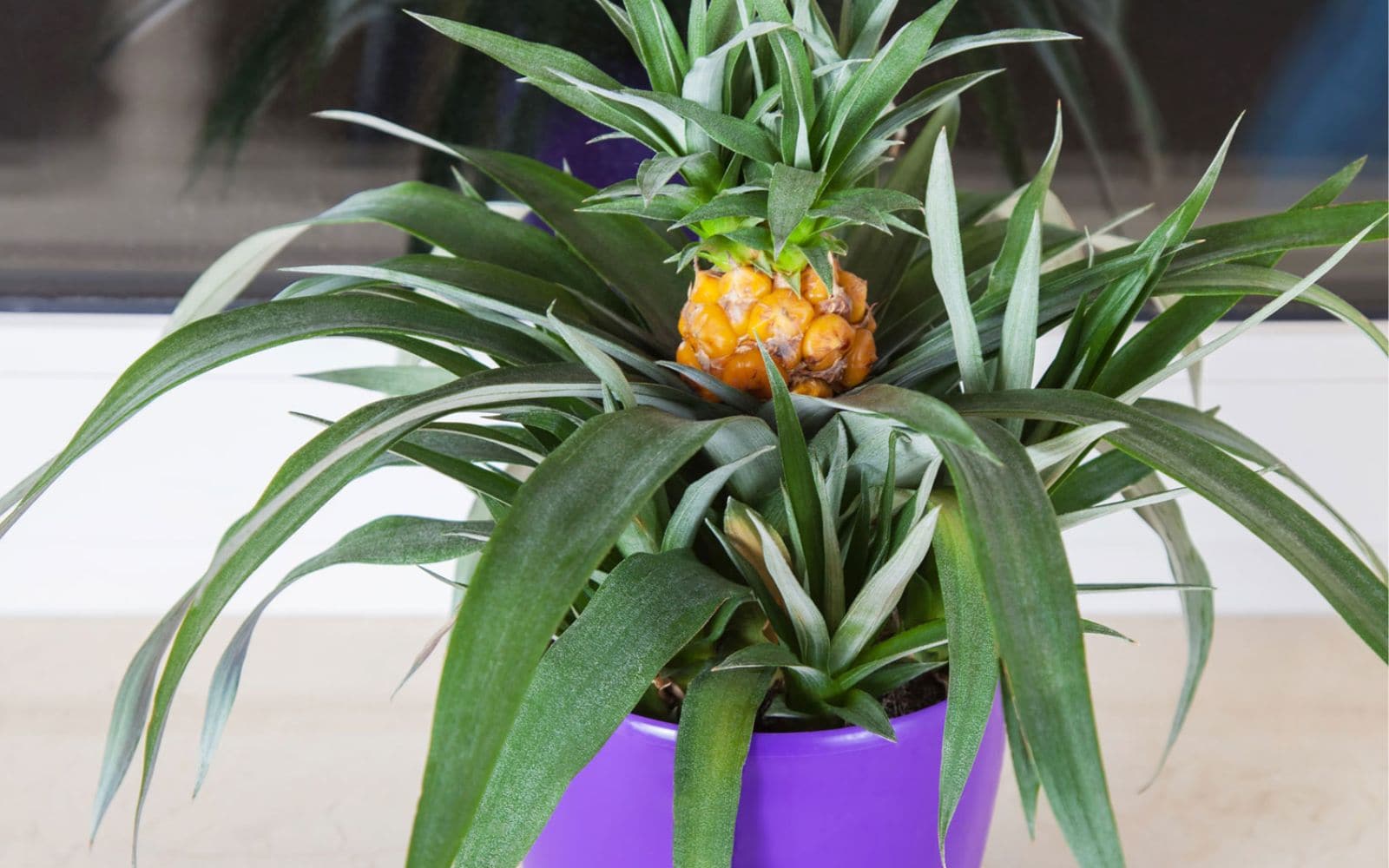
Can you grow pineapple plants indoors?
Yes, you can grow pineapple plants indoors in a container. But it’s recommended that you choose a dwarf species to grow indoors unless you have a large indoor space.
If you’re growing it indoors, make sure that the plant gets about 6 to 8 hours of sunlight.
With proper care, pineapple can start flowering when it matures. You can fasten the growth by providing the right nutrients, water, fertilizer, and sunlight.
The plant will have weak growth or tiny fruit if it doesn’t get the necessary growth environment.
Pineapple grows best outdoor in USDA hardiness zones of 11–12. If you’re planting indoors in a container, you can also grow it in the USDA hardiness zone of 4–11.
Remember that it won’t do very well when the temperature drops below freezing.
If you’re planting it outdoor in a container, you should consider bringing it indoors and a place where it can get bright sunlight.
You should plant pineapple in a group of 3 to 4 plants in a container garden to have a couple of pineapples to eat.
Can you grow a pineapple from seed?
Yes, you can grow a pineapple from seed, but it won’t be easy. Likely, you won’t find any seed from the store-bought pineapple.
While other tropical fruits such as bananas are cultivated to be seedless, the commercially grown pineapple can produce seed.
For the pineapple to grow seed, the flower needs to be pollinated by different pineapple flower species. If pollination doesn’t happen, the pineapple will be seedless.
However, if you want to produce a pineapple seed of your own, plant a different variety of pineapples together so birds can pollinate it.
You won’t get any seed if you plant the same pineapple as the pollens are genetically the same. The pineapple seeds are tiny and barely noticeable if you eat them.
Follow these steps to germinate the pineapple seed.
Step 1: Remove seeds carefully and rinse them gently. Remove any ripe fruit pulps from it.
Step 2: Place cleaned seeds in a paper towel and wrap it gently. You place it in a ziplock bag or plastic container and put it in a warm place, such as near the window. Moisten the paper towel regularly every two weeks.
Step 3: Pineapple seeds take 5 to 6 months to sprout. Remove any unhealthy or dead sprouts and select healthy and strong shoots for the plantation.
Step 4: Transfer healthy sprouts in a small container with moist soil and bury seeds a couple of inched inside.
Step 5: In a few months, the shoots will get bigger and ready to be transplanted in a bigger container or pot.
For the best growth, it should be planted at the location where it gets the full sun. It helps with flowering and fruit production.
If you’re planting it outdoor, make sure there is no large tree or building that could obstruct the direct light from reaching the plant.

How do you take care of the pineapple plant?
Pineapple is a very sturdy plant and won’t need much care. Depending on the variety of pineapples, they can grow big as most pineapple leaves grow 5 to 6 feet high and 3 to 4 feet wide.
When planting, makes sure there is enough spacing for the plant. Here are our care tips for the pineapple plant.
Soil
Pineapple likes fertile, sandy loam soil that helps provide its required nutrients. Ground with neutral to mild acidity levels helps with the growth. Interestingly, pineapple roots don’t grow very deep.
They need soil to provide essential nutrients and provide the support to remain upright. Make sure that the ground doesn’t retain water as it creates the risk of root rot.
Choosing a location where the soil can remain well-drained is ideal if you’re planting it outdoor. The short rooting of pineapple makes it suitable to grow in containers that you can move indoors.
Water
In a typical growing environment, you can water it once a week. Make sure there is enough moisture in the ground for the plant to grow.
Don’t overwater it to the point that it may make the soil soggy. The plant won’t like its roots to remain submerged in excess water.
You can water the plant when the topsoil starts to dry as they don’t lose much water through evaporation.
Do a finger test by inserting a finger a couple of inches down the sand and checking if it’s dry.
You can water the dry soil. It’s also recommended that you use a planter with a hole so it can drain any excess water.
Fertilizer
The pineapple plants need aggressive fertilization to grow healthy. This overwhelms people and makes it hard for them to know when they should fertilize the pineapple.
When you’re growing a new plant, at the start of the first 16 to 18 months, you need to provide fertilizer with a high NPK ratio. It helps with the growth of leaves that is necessary for a healthy plant.
We recommend that you use natural liquid houseplant fertilizer such a seaweed extract or fish emulsion. Fertilize the plant in small quantities every 6 to 8 weeks.
After 16 to 18 months, once the plant has become fully matured, use a fertilizer with a lower nitrogen concentration.
This helps with the flowering, and you should continue the same water and fertilization schedule.
You can add fertilizers to the ground directly, such as pelleted chicken manure or organic compost, for an extra boost.
You can check the color of leaves to determine if it’s growing healthy.
Leaves with a reddish-purple tinge indicate that it’s not getting the required nutrients, and you need to add some nutrients to the ground.
You can also use diluted solution to slow release 10-10-10 fertilizer during the early years of growth. These work great if you don’t want to spend maintaining your plant.
Some experts also recommend adding beneficial bacterial or Mycorrhizae fungi to the soil. It helps with efficient nutrient transmission to the plant.
You should also give pineapple a light dose of zinc sulfate that helps with growing strong foliage. Apply fertilizer directly on the roots and don’t spray it on leaves or flowers.
Sunlight
The plant grows best when the temperature is between 65 °F – 95 °F (8°C – 35°C).
Place it where it can get 6 to 8 hours of direct sunlight. If you’re planting it indoors, place it in a south-facing location for it to get more sunlight.
How do you make pineapple plant fruit?
A mature pineapple plant starts flowering 16 to 18 months after propagation. A larger and spread-out pineapple usually produces large pineapple, while a smaller plant will have smaller fruit.
You can encourage plants to grow fully by removing any suckers or slips growing at the plant. This helps the plant to have full nutrients available to flower and change into a fruit.
If you don’t remove these suckers, it also takes longer for the plant to reach its full maturity and produce fruit. Usually, pineapple plants with 75 to 85 full-grown leaves become ready to flower.
If you look at leaves closely, you will find that the sharp endpoints start to taper and won’t have spines at the edges.
It takes about five months for the flower to drop off and change into green pineapple.
The baby pineapple has a leaf on the top and is attached to a tiny purple tube. To get the full-size fruit, you want the plant to get big and fully matured.
If you don’t provide proper care or if the plant gets exposed to prolonged drought or cold, it may cause it to start flowering early, but you won’t get fully developed large fruit.
You can encourage fruition by dropping a pinch of calcium carbide at the plant’s center that stimulates the flowering fruition.
Remember that the fruit of mini pineapple isn’t edible, and you have to let it grow fully and get ripe before you attempt to eat it.
Outdoor planted pineapple won’t need much help to bear fruit, but you can help start flowering for an indoor plant.
You can place the indoor pineapple plant container in a large plastic bag and put 2–3 ripe apples in it and close the bag. In a few days, the apple starts to rot and produce ethylene gas that triggers flowering.
Once the flowering has started, you can remove the bag and place the planter to get direct sunlight. It may take up to 6 months from flowering to fruiting.
You can start harvesting once over 75% of its outer shell has turned from green to light yellow.
You can also harvest fully matured but not yet ripened pineapple and let it ripe gradually at room temperature.
A fully ripened pineapple can be held in a refrigerator for a week without getting spoiled. But you shouldn’t put green pineapple in the fridge; otherwise, it won’t ripen.
How do you take care of a pineapple plant in winter?
Pineapple is a tropical plant that needs full sunlight to grow properly. If you’re planting in a cooler area where the temperature drops below 60 °F (15 °C), you should plant it in a container that you can move indoors.
The plant will develop red and white patches on its leaf surface if it gets exposed to frost.
If you have planted it outdoor, you can cover it with a garden tarp, so the leaves and flowers don’t get exposed to frost and remain warm.
Reduce the watering frequency and only water when the ground has gone dry for optimal pineapple plant care.
Why do the tips of the pineapple plant turn brown?
There may be several reasons for the plant to turn brown. The most common cause is that the plant has completed its growing cycle and has produced fruit.
After this, the pineapple starts to fade and turn brown. There is nothing to do at this stage except you can create a new propagation.
If the plant hasn’t flowered yet and you see the leaves turning yellowish or brown, overwatering is the most common reason.
The root rot causes the leaves to wilt and turn yellow then brown. You should check the pineapple roots by gently removing the dirt around them.
If you see the root to be brownish and mushy or see any fungus sign, it means the root is getting rotten, and you need to dry out the ground.
You should stop watering till you know the plant has started regaining its health.
You should also repot the pineapple plants if the ground looks unhealthy and beyond recovery. Choose healthy soil, free from pests and weeds, and lightly moisten it to repot the pineapple.
Remove any existing root rot and change your watering schedule not to overwater it.
The other less common reason is under-watering. Pineapple is a drought-tolerant plant, but it needs moist ground to grow healthy.
If you haven’t watered the plant and the ground looks very dry, water the plant thoroughly till excess water starts draining out from the bottom of the pothole.
The other common but often overlooked reason for pineapple turning brown is a pest.
Pineapple is a sturdy plant and resistant to usual pests, but it has no defense for mealybug or Spanish moss. These are tiny insects that damage pineapple plants.
If you see mealybugs, scales, or mites growing on the plant, as tiny brown specs often at the leaves’ underside, you should make a plan to remove them immediately. You can use insecticidal soap or pesticides to get rid of these insects.
You can also wash out these pests with a water hose, then apply neem oil or alcohol over the affected area. Sometimes fungus gnats get in the moist soil to lay their egg and destroy the pineapple root.
You should let the ground get dry out between the watering schedule. Applying hydrogen peroxide to the soil helps kill these pests and fungi.
Are coffee grounds good for the pineapple plant?
Coffee grounds are a high source of nitrogen that helps with the initial growth of plants. You can sprinkle coffee ground on the pineapple plant’s soil and use it as a fertilizer.
Coffee grounds become slow-release fertilizer as they release the nutrients once the decomposition process starts in the soil.
If you’re sprinkling coffee grounds to the outside plant, it attracts beneficial microorganisms that help with the soil’s health.
The pineapple likes slightly neutral to acidic soil to grow fully. If you use a fresh coffee ground, it increases the acidity level. If you use a washed coffee ground, they will bring the soil to a neutral level without impacting the acidity level.
To make coffee groundwork effectively, sprinkle it into the ground and around the plant.
Besides providing fertilization, the coffee ground also helps control the weeds around the plant. Excessive weeds around the pineapple plant hinder its growth.
Note:
Don’t use coffee ground when you want it to start flowering. High nitrogen concentration nutrition can delay flowering. But it’s helpful when the plant is thriving in the first 16 to 18 months.
Should you cut dead leaves off the pineapple plant?
You can prune the plant from any dead leaves as it helps with fresh growth and maintains a healthy appearance when planting indoor. You can use a trimming scissor to remove these dead leaves.
But make sure that scissors are sterilized by soaking them in a bleach solution or rubbing alcohol on them.
This helps stop the transmission of fungus or other diseases from trimming scissors to the plant.
This is also an excellent time to remove any suckers or slips from the pineapple to help with flowering and growing bigger fruit.
Is pineapple poisonous to dogs and cats?
Pineapple fruit isn’t poisonous to dogs and cats and can be given in a small quantity.
But if you have a pineapple plant, prevent the dog from chewing on its leaves or eating the outer skin.
The stiff, fibrous leaves are thorny on the pet’s digestive system and become toxic if consumed in large quantities.
While the edible fruit isn’t toxic to pets, you should avoid giving your pets canned pineapple as they contain high sugar amount that isn’t good for pets.
Do pineapple plants purify the air?
Pineapples are naturally air purifying plants that can help improve the air quality in your home and office.
Not only do they cleanse the air, but they’re also decorative and are relatively easy to care for. The leaves of a pineapple plant release oxygen throughout the day.
When the sun hits the leaves, they convert carbon dioxide in the air into oxygen. At night, they release the oxygen they created. Pineapples also act as natural humidifiers.
Like many plants, pineapples release oxygen through their leaves, but the pineapple plant also releases water vapor through its leaves.
This moisture condenses on the leaves, and the plant releases it at night when it’s cooler.

Don’t forget to share this post

